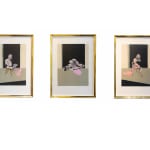Francis Bacon British, 1909-1992
Triptych August 1972, 1979
Series of three lithographs on Arches paper
Image: 65.5 x 48.5 cm (each)
Sheet: 89.5 x 61 cm (each)
Sheet: 89.5 x 61 cm (each)
© Estate of Francis Bacon
Further images
-
(View a larger image of thumbnail 1
)

-
(View a larger image of thumbnail 2
)

-
(View a larger image of thumbnail 3
)

-
(View a larger image of thumbnail 4
)

-
(View a larger image of thumbnail 5
)

-
(View a larger image of thumbnail 6
)

-
(View a larger image of thumbnail 7
)

-
(View a larger image of thumbnail 8
)

-
(View a larger image of thumbnail 9
)

-
(View a larger image of thumbnail 10
)

The present work is one in a series of Black Triptychs which Bacon produced after the suicide of his lover, George Dyer. Dyer is portrayed on the left, while Bacon...
The present work is one in a series of Black Triptychs which Bacon produced after the suicide of his lover, George Dyer. Dyer is portrayed on the left, while Bacon appears on the right and the central work is derived from a photograph of wrestlers by Edward Muybridge, although it may also be interpreted as a sexual encounter. Presented against a black void, Dyer is muscular and strong but at the same time his body is almost melting, falling apart. According to Bacon, his aim was to show "the life flowing out of him”.
In the left panel it seems as if the human flesh has flowed over the chair legs to the floor. The figure is also missed part of his torso. On the right panel the body has become liquid as well. This is one of the works in which Bacon devotes an ode to his deceased life partner, George Dyer. Although Bacon did not portray the deceased, the premature death of his lover haunted him so much that we continued to use Dyer as a model in the years following his departure from the world. In the middle panel, the human flesh is no longer clearly distinguishable as a figure, but appears to be two people making love. Physical entanglement in Bacon's work often has an explicit carnal nature, which just as easily evokes associations with tension as it does with an intimate bedroom scene.
Quote:
Francis Bacon, "people say you forget about death, but you don't. After all, I've had a very unfortunate life, because all the people I've been really fond of have died. And you don't stop thinking about them; time doesn't heal."
In the left panel it seems as if the human flesh has flowed over the chair legs to the floor. The figure is also missed part of his torso. On the right panel the body has become liquid as well. This is one of the works in which Bacon devotes an ode to his deceased life partner, George Dyer. Although Bacon did not portray the deceased, the premature death of his lover haunted him so much that we continued to use Dyer as a model in the years following his departure from the world. In the middle panel, the human flesh is no longer clearly distinguishable as a figure, but appears to be two people making love. Physical entanglement in Bacon's work often has an explicit carnal nature, which just as easily evokes associations with tension as it does with an intimate bedroom scene.
Quote:
Francis Bacon, "people say you forget about death, but you don't. After all, I've had a very unfortunate life, because all the people I've been really fond of have died. And you don't stop thinking about them; time doesn't heal."
Publications
Zweite, Armin (ed). The Violence of the Real. London: Thames and Hudson, 2006
Sylvester, David. The Brutality of Fact: Interviews With Francis Bacon. London: Thames and Hudson, 1987
1
of
36
















